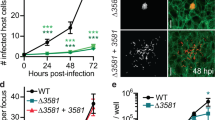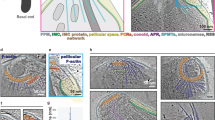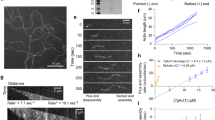Abstract
Apicomplexan parasites are an ancient group of protozoan parasites that includes several significant pathogens of humans and animals. To target and invade host cells they use a unique form of actin-based motility, called gliding motility. At the centre of the molecular motor that underlies this unique mode of locomotion are short, highly dynamic actin filaments. Recent molecular work, along with the availability of completed genomes for several Apicomplexa, has highlighted unique features of parasite actin and its regulation ? features that might provide new ways to block motility and, consequently, prevent infection and disease.
This is a preview of subscription content, access via your institution
Access options
Subscribe to this journal
Receive 12 print issues and online access
$209.00 per year
only $17.42 per issue
Buy this article
- Purchase on Springer Link
- Instant access to full article PDF
Prices may be subject to local taxes which are calculated during checkout




Similar content being viewed by others
References
Pollard, T. D. & Borisy, G. G. Cellular motility driven by assembly and disassembly of actin filaments. Cell 112, 453?465 (2003).
Stevens, J. M., Galyov, E. E. & Stevens, M. P. Actin-dependent movement of bacterial pathogens. Nature Rev. Microbiol. 4, 91?101 (2006).
Morrissette, N. S. & Sibley, L. D. Cytoskeleton of apicomplexan parasites. Microbiol. Mol. Biol. Rev. 66, 21?38 (2002).
Soldati, D. & Meissner, M. Toxoplasma as a novel system for motility. Curr. Opin. Cell. Biol. 16, 32?40 (2004).
King, C. A. Cell motility of sporozoan protozoa. Parasitol. Today 4, 315?319 (1988).
Blackman, M. J. & Bannister, L. H. Apical organelles of Apicomplexa: biology and isolation by subcellular fractionation. Mol. Biochem. Parasitol. 117, 11?25 (2001).
Cowman, A. F. & Crabb, B. S. Invasion of human red blood cells by malaria parasites. Cell 124, 755?766 (2006).
Carruthers, V. B. & Sibley, L. D. Sequential protein secretion from three distinct organelles of Toxoplasma gondii accompanies invasion of human fibroblasts. Eur. J. Cell Biol. 73, 114?123 (1997).
Alexander, D. L., Mital, J., Ward, G. E., Bradley, P. & Boothroyd, J. C. Identification of the moving junction complex of Toxoplasma gondii: a collaboration between distinct secretory organelles. PLoS Pathog. 1, e17 (2005).
Kappe, S. et al. Conservation of a gliding motility and cell invasion machinery in apicomplexan parasites. J. Cell Biol. 147, 937?944 (1999).
Baum, J. et al. A conserved molecular motor drives cell invasion and gliding motility across malaria lifecycle stages and other apicomplexan parasites. J. Biol. Chem. 281, 5197?5208 (2006).
Stewart, M. J. & Vanderberg, J. P. Malaria sporozoites leave behind trails of circumsporozoite protein during gliding motility. J. Protozool. 35, 389?393 (1988).
Russell, D. G. & Sinden, R. E. The role of the cytoskeleton in the motility of coccidian sporozoites. J. Cell Sci. 50, 345?359 (1981).
Ryning, F. W. & Remington, J. S. Effect of cytochalasin D on Toxoplasma gondii cell entry. Infect. Immun. 20, 739?743 (1978).
Wetzel, D. M., Schmidt, J., Kuhlenschmidt, M. S., Dubey, J. P. & Sibley, L. D. Gliding motility leads to active cellular invasion by Cryptosporidium parvum sporozoites. Infect. Immun. 73, 5379?5387 (2005).
Pinder, J. C. et al. Actomyosin motor in the merozoite of the malaria parasite, Plasmodium falciparum: implications for red cell invasion. J. Cell Sci. 111, 1831?1839 (1998).
Dobrowolski, J. M., Carruthers, V. B. & Sibley, L. D. Participation of myosin in gliding motility and host cell invasion by Toxoplasma gondii. Mol. Microbiol. 26, 163?173 (1997).
Dobrowolski, J. M., Niesman, I. R. & Sibley, L. D. Actin in the parasite Toxoplasma gondii is encoded by a single copy gene, ACT1 and exists primarily in a globular form. Cell Motil. Cytoskeleton 37, 253?262 (1997).
Patron, S. A. et al. Identification and purification of actin from the subpellicular network of Toxoplasma gondii tachyzoites. Int. J. Parasitol. 35, 883?894 (2005).
Trottein, F., Triglia, T. & Cowman, A. F. Molecular cloning of a gene from Plasmodium falciparum that codes for a protein sharing motifs found in adhesive molecules from mammals and plasmodia. Mol. Biochem. Parasitol. 74, 129?141 (1995).
Robson, K. J. et al. A highly conserved amino-acid sequence in thrombospondin, properdin and in proteins from sporozoites and blood stages of a human malaria parasite. Nature 335, 79?82 (1988).
Brossier, F. & Sibley, L. D. Toxoplasma gondii: microneme protein MIC2. Int. J. Biochem. Cell Biol. 37, 2266?2272 (2005).
Spano, F. et al. Molecular cloning and expression analysis of a Cryptosporidium parvum gene encoding a new member of the thrombospondin family. Mol. Biochem. Parasitol. 92, 147?162 (1998).
Jewett, T. J. & Sibley, L. D. Aldolase forms a bridge between cell surface adhesins and the actin cytoskeleton in apicomplexan parasites. Mol. Cell. 11, 885?894 (2003).
Buscaglia, C. A., Coppens, I., Hol, W. G. & Nussenzweig, V. Sites of interaction between aldolase and thrombospondin-related anonymous protein in plasmodium. Mol. Biol. Cell 14, 4947?4957 (2003).
Sultan, A. A. et al. TRAP is necessary for gliding motility and infectivity of plasmodium sporozoites. Cell 90, 511?522 (1997).
Yuda, M., Sakaida, H. & Chinzei, Y. Targeted disruption of the Plasmodium berghei CTRP gene reveals its essential role in malaria infection of the vector mosquito. J. Exp. Med. 190, 1711?1716 (1999).
Dessens, J. T. et al. CTRP is essential for mosquito infection by malaria ookinetes. EMBO J. 18, 6221?6227 (1999).
Bergman, L. W. et al. Myosin A tail domain interacting protein (MTIP) localizes to the inner membrane complex of Plasmodium sporozoites. J. Cell Sci. 116, 39?49 (2003).
Bosch, J. et al. Structure of the MTIP?MyoA complex, a key component of the malaria parasite invasion motor. Proc. Natl Acad. Sci. USA 103, 4852?4857 (2006).
Green, J. L. et al. The MTIP?myosin A complex in blood stage malaria parasites. J. Mol. Biol. 355, 933?941 (2006).
Jones, M. L., Kitson, E. L. & Rayner, J. C. Plasmodium falciparum erythrocyte invasion: a conserved myosin associated complex. Mol. Biochem. Parasitol. 147, 74?84 (2006).
Gaskins, E. et al. Identification of the membrane receptor of a class XIV myosin in Toxoplasma gondii. J. Cell Biol. 165, 383?393 (2004).
Foth, B. J., Goedecke, M. C. & Soldati, D. New insights into myosin evolution and classification. Proc. Natl Acad. Sci. USA 103, 3681?3686 (2006).
Herm-Gotz, A. et al. Toxoplasma gondii myosin A and its light chain: a fast, single-headed, plus-end-directed motor. EMBO J. 21, 2149?2158 (2002).
Meissner, M., Schluter, D. & Soldati, D. Role of Toxoplasma gondii myosin A in powering parasite gliding and host cell invasion. Science 298, 837?840 (2002).
Schmitz, S. et al. Malaria parasite actin filaments are very short. J. Mol. Biol. 349, 113?125 (2005).
Schuler, H., Mueller, A. K. & Matuschewski, K. Unusual properties of Plasmodium falciparum actin: new insights into microfilament dynamics of apicomplexan parasites. FEBS Lett. 579, 655?660 (2005).
Sahoo, N., Beatty, W., Heuser, J., Sept, D. & Sibley, L. D. Unusual kinetic and structural properties control rapid assembly and turnover of actin in the parasite Toxoplasma gondii. Mol. Biol. Cell 17, 895?906 (2005).
Revenu, C., Athman, R., Robine, S. & Louvard, D. The co-workers of actin filaments: from cell structures to signals. Nature Rev. Mol. Cell. Biol. 5, 635?646 (2004).
Bannister, L. H. & Mitchell, G. H. The role of the cytoskeleton in Plasmodium falciparum merozoite biology: an electron-microscopic view. Ann. Trop. Med. Parasitol. 89, 105?111 (1995).
Shaw, M. K. & Tilney, L. G. Induction of an acrosomal process in Toxoplasma gondii: visualization of actin filaments in a protozoan parasite. Proc. Natl Acad. Sci. USA 96, 9095?9099 (1999).
Field, S. J. et al. Actin in the merozoite of the malaria parasite, Plasmodium falciparum. Cell Motil. Cytoskeleton 25, 43?48 (1993).
Mizuno, Y. et al. Effect of jasplakinolide on the growth, invasion, and actin cytoskeleton of Plasmodium falciparum. Parasitol. Res. 88, 844?848 (2002).
Wetzel, D. M., Hakansson, S., Hu, K., Roos, D. & Sibley, L. D. Actin filament polymerization regulates gliding motility by apicomplexan parasites. Mol. Biol. Cell 14, 396?406 (2003).
Wesseling, J. G., Smits, M. A. & Schoenmakers, J. G. Extremely diverged actin proteins in Plasmodium falciparum. Mol. Biochem. Parasitol. 30, 143?153 (1988).
Kim, K., Gooze, L., Petersen, C., Gut, J. & Nelson, R. G. Isolation, sequence and molecular karyotype analysis of the actin gene of Cryptosporidium parvum. Mol. Biochem. Parasitol. 50, 105?113 (1992).
Wesseling, J. G. et al. Stage-specific expression and genomic organization of the actin genes of the malaria parasite Plasmodium falciparum. Mol. Biochem. Parasitol. 35, 167?176 (1989).
Kabsch, W., Mannherz, H. G., Suck, D., Pai, E. F. & Holmes, K. C. Atomic structure of the actin:DNase I complex. Nature 347, 37?44 (1990).
Dominguez, R. Actin-binding proteins ? a unifying hypothesis. Trends Biochem. Sci. 29, 572?578 (2004).
Abrahamsen, M. S. et al. Complete genome sequence of the apicomplexan, Cryptosporidium parvum. Science 304, 441?445 (2004).
Carlton, J. M. et al. Genome sequence and comparative analysis of the model rodent malaria parasite Plasmodium yoelii yoelii. Nature 419, 512?519 (2002).
Gardner, M. J. et al. Genome sequence of the human malaria parasite Plasmodium falciparum. Nature 419, 498?511 (2002).
Pain, A. et al. Genome of the host-cell transforming parasite Theileria annulata compared with T. parva. Science 309, 131?133 (2005).
Gordon, J. L. & Sibley, L. D. Comparative genome analysis reveals a conserved family of actin-like proteins in apicomplexan parasites. BMC Genomics 6, 179 (2005).
Ivens, A. C. et al. The genome of the kinetoplastid parasite, Leishmania major. Science 309, 436?442 (2005).
Baum, B. & Perrimon, N. Spatial control of the actin cytoskeleton in Drosophila epithelial cells. Nature Cell Biol. 3, 883?890 (2001).
Yarovinsky, F. et al. TLR11 activation of dendritic cells by a protozoan profilin-like protein. Science 308, 1626?1629 (2005).
Fetterer, R. H., Miska, K. B., Jenkins, M. C. & Barfield, R. C. A conserved 19-kDa Eimeria tenella antigen is a profilin-like protein. J. Parasitol. 90, 1321?1328 (2004).
Bozdech, Z. et al. Expression profiling of the schizont and trophozoite stages of Plasmodium falciparum with a long-oligonucleotide microarray. Genome Biol. 4, R9 (2003).
Le Roch, K. G. et al. Discovery of gene function by expression profiling of the malaria parasite life cycle. Science 301, 1503?1508 (2003).
Bamburg, J. R. Proteins of the ADF/cofilin family: essential regulators of actin dynamics. Annu. Rev. Cell Dev. Biol. 15, 185?230 (1999).
Allen, M. L., Dobrowolski, J. M., Muller, H., Sibley, L. D. & Mansour, T. E. Cloning and characterization of actin depolymerizing factor from Toxoplasma gondii. Mol. Biochem. Parasitol. 88, 43?52 (1997).
Schuler, H., Mueller, A. K. & Matuschewski, K. A Plasmodium actin-depolymerizing factor that binds exclusively to actin monomers. Mol. Biol. Cell 16, 4013?4023 (2005).
Huang, T. Y., Dermardirossian, C. & Bokoch, G. M. Cofilin phosphatases and regulation of actin dynamics. Curr. Opin. Cell Biol. 18, 26?31 (2006).
Baum, B., Li, W. & Perrimon, N. A cyclase-associated protein regulates actin and cell polarity during Drosophila oogenesis and in yeast. Curr. Biol. 10, 964?973 (2000).
Balcer, H. I. et al. Coordinated regulation of actin filament turnover by a high-molecular-weight Srv2/CAP complex, cofilin, profilin, and Aip1. Curr. Biol. 13, 2159?2169 (2003).
Goodson, H. V. & Hawse, W. F. Molecular evolution of the actin family. J. Cell Sci. 115, 2619?2622 (2002).
Quinlan, M. E., Heuser, J. E., Kerkhoff, E. & Mullins, R. D. Drosophila spire is an actin nucleation factor. Nature 433, 382?388 (2005).
Higgs, H. N. Formin proteins: a domain-based approach. Trends Biochem. Sci. 30, 342?353 (2005).
Tardieux, I. et al. A Plasmodium falciparum novel gene encoding a coronin-like protein which associates with actin filaments. FEBS Lett. 441, 251?256 (1998).
Poupel, O., Boleti, H., Axisa, S., Couture-Tosi, E. & Tardieux, I. Toxofilin, a novel actin-binding protein from Toxoplasma gondii, sequesters actin monomers and caps actin filaments. Mol. Biol. Cell 11, 355?368 (2000).
Carruthers, V. B. & Sibley, L. D. Mobilization of intracellular calcium stimulates microneme discharge in Toxoplasma gondii. Mol. Microbiol. 31, 421?428 (1999).
Lovett, J. L. & Sibley, L. D. Intracellular calcium stores in Toxoplasma gondii govern invasion of host cells. J. Cell Sci. 116, 3009?3016 (2003).
Ward, P., Equinet, L., Packer, J. & Doerig, C. Protein kinases of the human malaria parasite Plasmodium falciparum: the kinome of a divergent eukaryote. BMC Genomics 5, 79 (2004).
Kieschnick, H., Wakefield, T., Narducci, C. A. & Beckers, C. Toxoplasma gondii attachment to host cells is regulated by a calmodulin-like domain protein kinase. J. Biol. Chem. 276, 12369?12377 (2001).
Siden-Kiamos, I. et al. Plasmodium berghei calcium-dependent protein kinase 3 is required for ookinete gliding motility and mosquito midgut invasion. Mol. Microbiol. 60, 1355?1363 (2006).
Ishino, T., Orito, Y., Chinzei, Y. & Yuda, M. A calcium-dependent protein kinase regulates Plasmodium ookinete access to the midgut epithelial cell. Mol. Microbiol. 59, 1175?1184 (2006).
Snow, R. W., Guerra, C. A., Noor, A. M., Myint, H. Y. & Hay, S. I. The global distribution of clinical episodes of Plasmodium falciparum malaria. Nature 434, 214?217 (2005).
Brossier, F., Jewett, T. J., Sibley, L. D. & Urban, S. A spatially localized rhomboid protease cleaves cell surface adhesins essential for invasion by Toxoplasma. Proc. Natl Acad. Sci. USA 102, 4146?4151 (2005).
Dowse, T. J., Pascall, J. C., Brown, K. D. & Soldati, D. Apicomplexan rhomboids have a potential role in microneme protein cleavage during host cell invasion. Int. J. Parasitol. 35, 747?756 (2005).
Beltzner, C. C. & Pollard, T. D. Identification of functionally important residues of Arp2/3 complex by analysis of homology models from diverse species. J. Mol. Biol. 336, 551?565 (2004).
Acknowledgements
We apologize to many researches in this area who, because of the limits of space, we have not been able to cite directly. We are grateful to T. Nebl and O. Bernard for their comments on the manuscript, to B. Smith for generating the 3D-actin model and the anonymous reviewers for pointing out missing data in our initial analysis. Preliminary genomic data for T. gondii were accessed via http://ToxoDB.org and are provided by The Institute for Genomic Research (supported by a National Institutes of Health grant) and by the Wellcome Trust Sanger Institute. J.B. is funded by a Peter Doherty research fellowship from the National Health and Medical Research Council (NHMRC). A.F.C. is a Howard Hughes International Research Scholar. This work was funded by the NHMRC and the Wellcome Trust.
Author information
Authors and Affiliations
Corresponding author
Ethics declarations
Competing interests
The authors declare no competing financial interests.
Related links
Related links
DATABASES
Entrez Genome Project
FURTHER INFORMATION
Wellcome Trust Sanger Institute protozoan genome sequencing projects
Rights and permissions
About this article
Cite this article
Baum, J., Papenfuss, A., Baum, B. et al. Regulation of apicomplexan actin-based motility. Nat Rev Microbiol 4, 621–628 (2006). https://doi.org/10.1038/nrmicro1465
Issue Date:
DOI: https://doi.org/10.1038/nrmicro1465
This article is cited by
-
Comparative analyses of functional antibody-mediated inhibition with anti-circumsporozoite monoclonal antibodies against transgenic Plasmodium berghei
Malaria Journal (2023)
-
Marine gregarine genomes reveal the breadth of apicomplexan diversity with a partially conserved glideosome machinery
BMC Genomics (2022)
-
4D analysis of malaria parasite invasion offers insights into erythrocyte membrane remodeling and parasitophorous vacuole formation
Nature Communications (2021)
-
Plasmodium falciparum coronin organizes arrays of parallel actin filaments potentially guiding directional motility in invasive malaria parasites
Malaria Journal (2015)
-
Inhibition by stabilization: targeting the Plasmodium falciparum aldolase–TRAP complex
Malaria Journal (2015)



